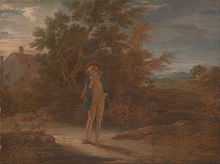The Seven Ages of Man (painting series)
_by_Charles_Picart_(1780_-_1837).jpg)
The Seven Ages of Man is a series of paintings by Robert Smirke, derived from a monologue from William Shakespeare's As You Like It, spoken by the melancholy Jaques in Act II Scene VII. The phrase begins as all the world's a stage. The stages referred are: infant, schoolboy, lover, soldier, justice, pantaloon and old age.[1][2][3][4][5][6]
Painted between 1798 and 1801, they depict the journey of life in its various forms.[7] They were produced for the Boydell Shakespeare Gallery,[8][9] and engravings by Peltro William Tomkins, John Ogborne, Robert Thew, Peter Simon the Younger and William Satchwell Leney based on Smirke's paintings were included in the gallery's folio edition of Shakespeare's work.[10]
Background
In 1796, Robert Smirke agreed to paint William Shakespeare's The Seven Ages of Man for John and Josiah Boydell's Shakespeare Gallery.[11]
The seven ages
The character Jaques expresses the ages as the following stages:







The Infancy
In this stage the man is born as a helpless baby and knows little but waiting as a man in embryo to spring out.[12]
The Schoolboy
Here, he begins his schooling and is unwilling to go to school; the charms of helpless innocence cease.[12]
The Lover
The lover is depicted as a young man composing his love poems, shown beneath two pictures of Cupid, the god of love and on the left, Romeo-Juliet balcony scene.[13]
The Soldier
Here, he is hot-blooded with a high degree of self-respect. He looks forward to gaining a reputation, even if it costs him his life. He is inflamed with the love of war and, like a leopard, he charges.[12]
The Justice
Here, he attains a socially accepted state and expounds the wisdom he has gained in his life.[12]
The Pantaloon
Here, he tries to shrink himself into a shell of his worries and is indifferent to his physical appearance and apparel, just as he was in his youth.[12]
The Old Age
Now he is bound to be dependent on others and there comes an end to 'the strange eventful history' which is nothing but a repetition of the first stage, infancy, lacking all the senses and everything.[14]
The monologue
"All the world's a stage,
-Act II, Scene VII, Shakespeare's As You Like It[15]
And all the men and women merely players.
They have their exits and their entrances,
And one man in his time plays many parts,
His acts being seven ages. At first the infant,
Mewling and puking in the nurse's arms.
Then, the whining school-boy with his satchel
And shining morning face, creeping like snail
Unwillingly to school. And then the lover,
Sighing like furnace, with a woeful ballad
Made to his mistress' eyebrow. Then, a soldier,
Full of strange oaths, and bearded like the pard,
Jealous in honour, sudden, and quick in quarrel,
Seeking the bubble reputation
Even in the cannon's mouth. And then, the justice,
In fair round belly, with a good capon lined,
With eyes severe, and beard of formal cut,
Full of wise saws, and modern instances,
And so he plays his part. The sixth age shifts
Into the lean and slippered pantaloon,
With spectacles on nose and pouch on side,
His youthful hose, well saved, a world too wide
For his shrunk shank, and his big manly voice,
Turning again toward childish treble, pipes
And whistles in his sound. Last scene of all,
That ends this strange eventful history,
Is second childishness and mere oblivion,
Sans teeth, sans eyes, sans taste, sans everything."
See also
References
- ↑ "Robert Smirke (1752–1845)". Dictionary of National Biography, 1885–1900 52.
- ↑ "The Seven Ages of Man The Infant from Act II, Scene vii of As You Like it by William Shakespeare c.1798–1801". 1st Art Gallery Inc. Retrieved January 15, 2015.
- ↑ "Peltro William Tomkins & Robert Smirke: As You Like It (The Seven Ages of Man: The First Age)". Art of The Print. Retrieved January 15, 2015.
- ↑ Rusche, Harry. "Shakespeare Illustrated, The Artists: Robert Smirke, 7. The Seven Ages of Man". Emory University. Retrieved January 15, 2015.
- ↑ Highfill, Philip H.; Burnim, Kalman A.; Langhans, Edward A. A Biographical Dictionary of Actors, Actresses, Musicians, Dancers, Managers, and Other Stage Personnel in London, 1660–1800 14. p. 129.
- ↑ Ritchie, Fiona; Sabor, Peter. Shakespeare in the Eighteenth Century. p. 245.
- ↑ Thomas R. Cole. The Journey of Life: A Cultural History of Aging in America. p. 24, note 64.
- ↑ International Shakespeare Association. Congress (1986). Images of Shakespeare: Proceedings of the Third Congress of the International Shakespeare Association, 1986. International Shakespeare Association. Congress. p. 122.
- ↑ Wigston Smith, Chloe. Women, Work, and Clothes in the Eighteenth-Century Novel. p. 56.
- ↑ Friedman, Winifred H. (1976). Boydell's Shakespeare Gallery. New York: Garland Publishing Inc. pp. 203,211.
- ↑ Ayres, James. Art, Artisans and Apprentices: Apprentice Painters & Sculptors in the Early Modern British Tradition. Oxbow Books. p. 17.
- ↑ 12.0 12.1 12.2 12.3 12.4 Evans, John. The progress of human life: Shakespeare's Seven ages of man. p. .
- ↑ Shaughnessy, Robert. The Cambridge Companion to Shakespeare and Popular Culture. p. 77.
- ↑ Routledge, G. (1867). The Shakespeare Gallery.
- ↑ Shakespeare, William. "As You Like It, Scene 7, Act 2". Retrieved January 18, 2015.
Attribution
![]() This article incorporates text from a publication now in the public domain: Lee, Sidney, ed. (1897). "Smirke, Robert". Dictionary of National Biography 52. London: Smith, Elder & Co.
This article incorporates text from a publication now in the public domain: Lee, Sidney, ed. (1897). "Smirke, Robert". Dictionary of National Biography 52. London: Smith, Elder & Co.